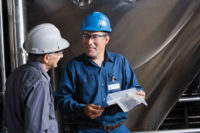How do you influence behavior?

It’s almost lunchtime and the behavioral safety class has been discussing employee motivation, incentives and positive reinforcement for most of the morning. The last comment comes from the least participating class attendee, “How can they motivate me? They don’t even know who I am!”
Employee motivation affects the strength of the drive, the amount of dedication and the level of resourcefulness employees will apply to their jobs. A highly motivated workforce will not only increase productivity and quality but can provide management more opportunity to grow the business. Most studies reveal that employees want to be enthusiastic about their job or the purpose of their job, and when they are they work harder and more effectively at it.
Feeling “inâ€
That said, what motivates? Job satisfaction surveys have been done for many years. Back in 1949, a well known study by Lawrence Lindahl revealed that the top two job rewards listed by workers were full appreciation for work done and feeling “in” on things. Many were shocked at these findings as most believed that monetary rewards would lead the list. This type of study has been repeated many times over, all with basically the same results.It’s not certain when we decided that we could influence behavior by bribery, offering appealing rewards to affect performance. Maybe it goes back to our childhood. “If you clean your room, you’ll get that game you’ve been wanting.” The room gets cleaned… that time. The reward is soon forgotten and the room goes back to its messy state once again.
This is not to say that monetary rewards don’t matter. We all need to pay our bills and maintain a certain desired level of living. However, increasing evidence says this in itself will not motivate most people to excel or go beyond the average performance level. Most rewards will only affect a short-term enhancement, just like punishment or threats. What are called “incentives” are continually used in an attempt to gain superior results.
Most dictionaries define “incentive” as something that stimulates to an action or urges a person on. The elements that sustain higher performance for the long-term center around the feeling of making a contribution; recognition from superiors; respect from our co-workers; opportunity to be involved and informed about what’s happening; having meaningful work. Like we saw in the statement made in the opening paragraph, most workers are just looking for some recognition.
Put into practice
All this theory is whiteboard enthusiasm unless we truly put it into practice. Some of the ways this can be done include:Job training — Too often, people are put to work with very little knowledge of what makes them safe, and how their job and safety affects the people around them and the end-product. Understanding the job function and its importance in the big picture goes a long way in motivating workers.
Involvement — Give the opportunity to employees to be involved in defining the job, including safe practices.
Creativity and empowerment — Allow employees to contribute ideas to make their work better and involve them in decisions that affect them. Foster a sense of ownership by asking for their input.
Growth — Give employees the chance to grow and learn new skills if they desire it.
Listen — Recognize what is said and address issues. Ignoring employees after they offer suggestions or reveal real or perceived problems can kill their motivation. While not all issues can be resolved, if solid reasons are given most employees are appreciative of the facts.
Recognize — Personally thank people for doing a good job both verbally and in writing. Do this immediately and often for specific reasons/actions. By all means be sincere. Provide specific feedback about performance.
Handle failures and mistakes constructively — Analyze the mistakes, and then plan for improvement or correction together with the employee.
Create some fun — Celebrate successes of the company, the department and the individuals in it. Provide a fun celebration for a specific accomplishment.
Reward — Rewards do not have to be cash or trinkets. During peak business cycles, recognize the extra work, the fatigue and offer additional breaks and healthy drinks and other refreshments. Show that the extra effort is appreciated. Plan for an appreciation event when work slows down.
Learn to know your employees — Take a walk (often) and acknowledge employees. Try to learn their names. Notice what they do, and find out what they like. Allow workers to feel like they are an important part of the process — which they are.
Motivation is an integral part of every aspect of an employee’s job, including safety. Recognition, involvement and appreciation are positive ways to motivate employees to work effectively and safely.
Looking for a reprint of this article?
From high-res PDFs to custom plaques, order your copy today!




